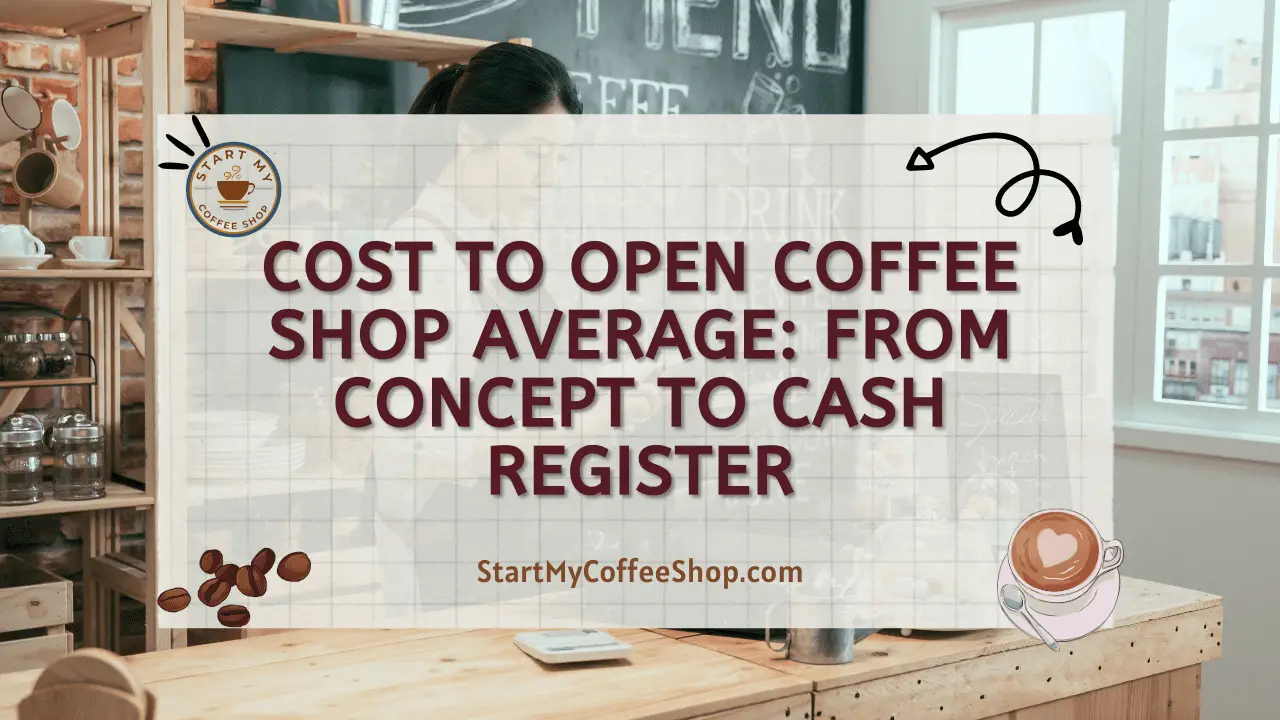Opening a coffee shop is a dream for many aspiring entrepreneurs, as it combines the love for coffee, the joy of creating a cozy atmosphere, and the opportunity to connect with customers. However, turning this dream into reality requires careful planning, including understanding the financial implications.
The average cost to open a coffee shop can vary depending on factors such as location, size, leasehold improvements, equipment, licenses, and staffing. It’s important to conduct thorough research and create a detailed business plan to estimate your specific costs accurately.
In this article, I will delve into the average cost of opening a coffee shop and explore the various factors that contribute to it.
1. Location:
 In general, popular areas with high foot traffic tend to come with higher leasing costs. These locations offer the advantage of a built-in customer base, as passersby are more likely to stop for a cup of coffee. However, the higher rent prices associated with these areas can place a strain on your initial investment and ongoing expenses.
In general, popular areas with high foot traffic tend to come with higher leasing costs. These locations offer the advantage of a built-in customer base, as passersby are more likely to stop for a cup of coffee. However, the higher rent prices associated with these areas can place a strain on your initial investment and ongoing expenses.
On the other hand, choosing a location in a less crowded or up-and-coming neighborhood may offer more affordable rent prices. While foot traffic might be lower initially, you have the opportunity to attract and build a loyal customer base over time. It’s essential to conduct thorough research on the local market and understand customer preferences to make an informed decision.
Consider factors such as the demographics of the area, the presence of other coffee shops or competitors, and the overall atmosphere and vibe that aligns with your desired coffee shop concept. Analyze foot traffic patterns, both during weekdays and weekends, to determine the potential customer flow in different locations.
Additionally, think about the accessibility and parking options available to your customers. Convenient parking can greatly enhance the customer experience and attract more visitors to your coffee shop.
By taking the time to research and analyze different locations, you can find the optimal balance between rent costs and potential customer traffic. This will help you make a well-informed decision that aligns with your business goals and financial capabilities.
Ultimately, the location of your coffee shop is a strategic choice that can significantly impact your business. By carefully considering rent prices, foot traffic, customer preferences, and other relevant factors, you can position your coffee shop for progress while managing the associated costs effectively.
Read more about Best Nespresso Coffee Maker: Finding Perfection in Every Cup
2. Leasehold Improvements:
The costs associated with leasehold improvements can vary greatly depending on the scale and complexity of the project. In some cases, the space may already have the necessary infrastructure in place, requiring only minor cosmetic adjustments to align with your coffee shop’s theme and branding. This scenario would typically entail moderate costs for cosmetic changes, such as repainting walls, updating fixtures, or adding decorative elements.
However, if the chosen space is a blank canvas or requires significant structural modifications, the costs of leasehold improvements can become substantial. This may involve more extensive renovations, such as installing new plumbing or electrical systems, replacing flooring, adding partitions or walls, or redesigning the layout to optimize customer flow. These structural changes can contribute to higher expenses due to materials, labor, and potential permits required.
Additionally, the desired ambiance and level of sophistication you wish to achieve in your coffee shop can influence the costs of leasehold improvements. For instance, if you aim for a high-end, luxurious atmosphere, it may involve investing in premium materials, customized furniture, intricate lighting designs, or unique architectural features. On the other hand, a more casual and cozy setting could allow for a simpler and cost-effective approach to leasehold improvements.
To manage the costs of leasehold improvements effectively, it is crucial to establish a clear vision for your coffee shop’s aesthetics and functionality. Working closely with an experienced designer or architect can help you make informed decisions about the necessary improvements and find cost-effective solutions without compromising on quality or customer experience.
Furthermore, obtaining multiple quotes from contractors and suppliers can help you compare prices and negotiate the best deals for materials and labor. It’s also essential to account for unexpected expenses by setting aside a contingency budget to accommodate any unforeseen challenges or additional requirements that may arise during the renovation process.
3. Equipment and Inventory:
The cost of equipment and initial inventory can vary significantly depending on the scale of your operations and the quality of products you choose. For smaller coffee shops or those with a limited menu, investing in entry-level or refurbished equipment can be a more cost-effective approach. These options can help you get started without breaking the bank while still maintaining a decent level of quality.
However, if you aim to offer a diverse range of specialty coffees and beverages, investing in higher-end equipment may be necessary. This can include top-of-the-line espresso machines, advanced grinders, and specialized brewing equipment. Such equipment often comes with a higher price tag due to advanced features, durability, and the ability to handle higher volumes.
In addition to equipment costs, you’ll need to stock up on initial inventory, which includes coffee beans, tea, syrups, milk, cups, and other essential supplies. The specific products and quantities will depend on your menu offerings and projected customer demand. Sourcing high-quality ingredients and supplies is essential for delivering consistent flavors and meeting customer expectations.
When estimating the cost of equipment and inventory, it’s important to consider factors such as the projected customer volume, the frequency of supplier deliveries, and any seasonal fluctuations in demand. Planning and forecasting your inventory needs will help you avoid overstocking or running out of crucial supplies.
To manage these costs effectively, it’s advisable to explore different suppliers and negotiate favorable terms, especially if you plan to establish long-term partnerships. Bulk purchasing can often lead to discounted prices, helping you save on recurring expenses.
Additionally, consider the importance of equipment maintenance and servicing costs. Regular upkeep and servicing of your machines will ensure their longevity and prevent unexpected breakdowns. Including these costs in your budget will help you plan for ongoing maintenance and ensure that your equipment continues to operate smoothly.
Lastly, it’s essential to factor in potential training costs for your staff. Baristas should receive proper training on operating the equipment, making consistent coffee, and providing exceptional customer service. Training programs and certifications might come with associated costs, but they are crucial for maintaining quality and customer satisfaction.
4. Licenses and Permits:
One common permit that you will likely need is a health permit. This ensures that your coffee shop meets the necessary health and safety standards set by local health departments. It involves inspections of your premises, equipment, and processes to ensure proper hygiene and food handling practices.
Food handling permits are often required as well, especially if your coffee shop offers food items alongside beverages. These permits demonstrate that you and your staff have received proper training in safe food handling procedures, minimizing the risk of foodborne illnesses.
Zoning permits are another critical aspect to consider. These permits ensure that your coffee shop is located in a designated area for commercial use and complies with local zoning regulations. Zoning laws dictate the type of businesses allowed in specific areas, so it’s essential to ensure your location is suitable for a coffee shop.
Additionally, you will need to obtain a business license, which grants you the legal right to operate a business in a specific jurisdiction. This license serves as proof that your coffee shop meets the local requirements and regulations for operating a commercial establishment.
Researching the specific licenses and permits required in your area is paramount. Contact your local government offices, such as the city or county clerk’s office, health department, or small business administration, to obtain the necessary information. They can provide you with the exact permits you need and guide you through the application process.
It’s important to allocate funds for application fees associated with these licenses and permits. The fees can vary depending on the jurisdiction and the type of permit required. Additionally, some permits may require professional assistance, such as legal or consulting services, to navigate the application process effectively.
To ensure a smooth and efficient application process, consider seeking professional guidance. Consultants or attorneys with experience in the hospitality industry can provide valuable insights and assistance in completing the necessary paperwork accurately.
Remember, obtaining the required licenses and permits is not only a legal obligation but also a crucial step in establishing trust with your customers. It demonstrates your commitment to maintaining high standards of quality, safety, and compliance.
Read more about Best Nespresso Machine for Iced Coffee: Your Way to Iced Coffee Nirvana
5. Staffing and Training:
 The first step is to identify the roles and responsibilities required to operate your coffee shop effectively. This typically includes positions such as baristas, cashiers, kitchen staff, and potentially managerial or supervisory roles. The number of employees needed will depend on factors such as the volume of customers, peak hours, and the complexity of your menu.
The first step is to identify the roles and responsibilities required to operate your coffee shop effectively. This typically includes positions such as baristas, cashiers, kitchen staff, and potentially managerial or supervisory roles. The number of employees needed will depend on factors such as the volume of customers, peak hours, and the complexity of your menu.
When budgeting for staffing costs, it’s important to consider not only the base salaries but also additional expenses such as benefits and payroll taxes. Benefits can include healthcare coverage, paid time off, retirement plans, and other perks that attract and retain quality employees. Payroll taxes, including Social Security and Medicare contributions, must also be accounted for.
In addition to compensation, allocating funds for staff training is essential. Proper training ensures that your employees are well-equipped to provide exceptional customer service and maintain consistency in coffee preparation. Training costs may involve conducting in-house training programs, hiring external trainers, or investing in online training resources. Well-trained employees are more likely to deliver a positive experience to customers, leading to increased customer satisfaction and loyalty.
To manage staffing costs effectively, it’s crucial to strike a balance between providing competitive compensation and maintaining financial sustainability. Consider the local labor market and industry standards when determining appropriate salary ranges. While it’s important to attract and retain talented individuals, it’s also essential to ensure that your staffing costs align with your overall budget and financial goals.
Optimizing employee scheduling is another way to control staffing costs. By carefully analyzing customer flow patterns, peak hours, and seasonal variations, you can create efficient schedules that align with customer demand while minimizing labor expenses during slower periods.
Furthermore, fostering a positive work environment and investing in employee engagement can contribute to staff retention and satisfaction. Happy employees are more likely to provide exceptional service, resulting in increased customer loyalty and positive word-of-mouth.
Lastly, it’s important to stay updated on employment laws and regulations to ensure compliance with labor standards. This includes minimum wage requirements, overtime rules, and any specific regulations related to the hospitality industry in your area.
6. Marketing and Branding:
Investing in eye-catching signage is a great way to capture the attention of passersby and create awareness of your coffee shop. Whether it’s an attractive storefront sign or strategically placed banners, clear and visually appealing signage helps draw customers into your establishment.
Menus play a vital role in showcasing your offerings and enticing customers to try your coffee and other beverages. Designing and printing high-quality menus that reflect your brand’s identity and highlight your unique offerings can be a worthwhile investment.
Business cards are a tangible representation of your coffee shop and can be distributed to potential customers or local businesses to encourage referrals. A well-designed business card with your contact information and a glimpse of your brand aesthetic can leave a lasting impression on people who come across it.
In today’s digital age, online promotion is essential for reaching a broader audience. Allocating a portion of your marketing budget to online platforms such as social media advertising, search engine optimization (SEO), and targeted digital marketing campaigns can help increase brand visibility and attract customers who may not have otherwise discovered your coffee shop.
Collaborating with local influencers or bloggers who have a strong online presence can be a cost-effective marketing strategy. Their endorsement and positive reviews of your coffee shop can significantly impact brand awareness and attract a dedicated following of potential customers.
Hosting community events, such as coffee tastings, live music performances, or charity fundraisers, can create a positive image for your coffee shop within the local community. Such events not only showcase your products but also demonstrate your commitment to fostering community engagement.
Implementing a loyalty program is an effective way to retain existing customers and encourage repeat business. Offering incentives, such as discounts, freebies, or exclusive promotions, can not only boost customer loyalty but also attract new customers through positive word-of-mouth.
7. Utilities and Operating Expenses:
When operating a coffee shop, it’s essential to account for ongoing expenses to maintain a sustainable business. These expenses typically include utilities, rent or mortgage payments, insurance, and maintenance costs.
Utilities such as electricity, water, and gas are essential for the day-to-day operations of your coffee shop. Your equipment, lighting, heating or cooling systems, and other appliances rely on these utilities. It’s important to estimate and budget for these expenses based on historical usage, projected growth, and the rates set by utility providers.
Rent or mortgage payments are significant costs that depend on the location and size of your coffee shop. Leasing costs can vary widely based on factors such as the city, neighborhood, and foot traffic in the area. It’s crucial to carefully consider these expenses when choosing a location for your coffee shop, as they directly impact your profitability.
Insurance is another necessary expense to protect your coffee shop from potential risks. General liability insurance, property insurance, and worker’s compensation insurance are common types of coverage needed in the food service industry.
The cost of insurance will depend on factors such as the size of your coffee shop, its location, and the coverage limits you choose. Consulting with an insurance professional can help you understand the specific coverage needs of your business and obtain accurate cost estimates.
Maintenance costs should also be factored into your operational expenses. Regular maintenance and repairs of equipment, plumbing, electrical systems, and other aspects of your coffee shop are necessary to ensure smooth operations and prevent costly breakdowns. Allocating funds for ongoing maintenance and occasional unexpected repairs is important for the longevity and efficiency of your business.
To estimate these operational expenses accurately, it’s advisable to review historical data, consult with industry experts, and seek advice from experienced coffee shop owners. Additionally, creating a contingency fund for unforeseen expenses can provide a safety net and help you navigate unexpected financial challenges.
Monitoring and reviewing these expenses regularly will allow you to identify areas where cost savings can be made or efficiency improvements can be implemented. Exploring energy-saving initiatives, negotiating with utility providers, and seeking competitive quotes for insurance coverage are all strategies to manage these ongoing expenses effectively.
8. Contingency Funds:
When running a coffee shop, it’s important to establish a contingency fund to prepare for unexpected expenses and navigate through challenging periods. Unforeseen repairs, equipment breakdowns, or fluctuations in sales can significantly impact your finances. By setting aside a reserve fund, you create a safety net that provides financial security and peace of mind.
Unanticipated expenses can arise at any time. Equipment malfunctions or sudden repairs may be necessary to ensure the smooth operation of your coffee shop. These unexpected costs can strain your budget if you haven’t allocated funds specifically for such situations. By having a contingency fund, you can address these unforeseen expenses without compromising your daily operations or dipping into other essential funds.
Furthermore, fluctuating sales are a reality for many businesses, including coffee shops. Seasonal variations, economic downturns, or unexpected changes in customer behavior can lead to lean periods with reduced revenue. During these times, having a reserve fund can help cover operational costs and maintain your coffee shop’s stability until sales pick up again.
The size of your contingency fund will depend on various factors, such as the size of your coffee shop, your operating costs, and the level of risk associated with your specific circumstances. It’s advisable to set aside a portion of your profits regularly to gradually build up the reserve fund. Consider consulting with a financial advisor or accountant to determine an appropriate amount based on your unique situation.
Having a contingency fund not only provides financial security but also allows you to respond swiftly to unexpected situations. It helps you avoid the stress and pressure of scrambling for funds when faced with an emergency or unforeseen expense. Instead, you can address the issue promptly and maintain the continuity of your coffee shop’s operations.
Summary
While the average cost to open a coffee shop can vary greatly depending on factors such as location, size, and concept, it’s essential to conduct thorough research and create a detailed business plan to estimate your specific costs accurately. From leasing space to purchasing equipment, hiring staff, and marketing your brand, understanding the financial implications will help you make informed decisions and set realistic expectations for your coffee shop venture.
Remember, starting a coffee shop is not just a financial investment; it’s an opportunity to create a welcoming space where people can gather and enjoy a good cup of coffee. By considering all aspects of cost and planning accordingly, you’ll be on your way to turning your coffee shop dreams into a thriving reality.
Frequently Asked Questions
Question: How much does equipment for a coffee shop typically cost?
Answer: Generally, espresso machines, grinders, refrigerators, and other essential equipment can range from a few thousand dollars to tens of thousands of dollars.
Question: What licenses and permits are needed to open a coffee shop?
Answer: Common permits may include health permits, food handling permits, zoning permits, and business licenses.
Question: How many staff do I need to hire for my coffee shop?
Answer: The number of staff you need to hire for your coffee shop depends on the size of your establishment and the level of service you aim to provide.
To learn more on how to start your own coffee shop checkout my startup documents here
Please note: This blog post is for educational purposes only and does not constitute legal advice. Please consult a legal expert to address your specific needs.

Hi! I’m Shawn Chun
My adventure in coffee began when I first launched my first coffee shop back in the early 2000s. I had to figure out so many things on my own and to make it worse within 2 years of opening two large corporate coffee chains moved in just blocks away from me!
As I saw smaller and even some larger coffee shops in the neighborhood slowly lose customers to these giant coffee chains and slowly close up shop, I knew that I had to start getting creative…or go out of business.
I (like you may be) knew the coffee industry well. I could make the best latte art around and the foam on my caps was the fluffiest you have ever seen. I even had the best state-of-the-art 2 group digital Nuova Simonelli machine money could buy. But I knew that these things alone would not be enough to lure customers away from the name brand established coffee shops.
Eventually, through lots of trial and error as well as perseverance and creativity I did find a way to not only survive but also thrive in the coffee/espresso industry even while those corporate coffee chains stayed put. During those years I learned to adapt and always faced new challenges. It was not always easy, however, in the end, I was the sole survivor independent coffee shop within a 10-mile radius of my location. Just two corporate coffee chains and I were left after that year. All told the corporate coffee chains took down over 15 small independent coffee shops and kiosks and I was the last one standing and thriving.
Along the years I meet others with the same passion for coffee and I quickly learned that it is not only “how good a barista is” that makes a coffee shop successful, but the business side of coffee as well.
Hence why I started this website you are on now. To provide the tools and resources for up and coming coffee shop owners to gain that vital insight and knowledge on how to start a coffee shop successfully.
Stick around, browse through my helpful blog and resources and enjoy your stay! With lots of LATTE LOVE!
Shawn






